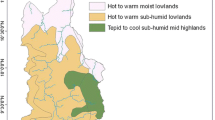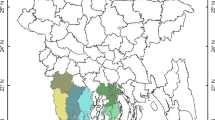Abstract
Climate change poses a major threat to the semi-arid tropics, which is characterized by scanty and uncertain rainfall, infertile soils, poor infrastructure, extreme poverty and rapid population growth. These conditions present serious environmental, economic and social impacts on the agricultural community. In recent years, adaptation to climate change has become a major concern to farmers, researchers and policy makers alike. To enhance policy towards tackling the challenges that climate change poses to farmers, it is important to have knowledge on their perceptions of climate change, potential adaptation measures and factors affecting adaptation. In addition, the extent to which farmers’ perceptions on climate change coincide with actual climatic data needs to be further examined. This paper, using a qualitative approach, looks into the perceived changes in rainfall and temperature, their impacts and adaptations strategies taken up by farmers in four villages in the states of Maharashtra and Andhra Pradesh. It also analyses the accuracy of these perceptions based on actual available climatic data. The paper also looks into the determinants of adaptive capacity by examining a case of improved water management as an adaptation mechanism.


Similar content being viewed by others
Notes
This process could be in the form of access to certain institutions, community initiatives or even self-motivated entrepreneurial skills of the individual.
White fly was identified as one of the pests which was observed to have increased in the past 5 years for the paddy crops by the respondents in V3.
Equivalent to 50 cents in USD.
Shed nets comprise of the use of a nylon net to cover the particular area of the vegetable crops along with polythene strips. The initial investment for setting up a shed net is about $500.
As mentioned by the community.
References
Adger WN, Brown K, Fairbrass J, Jordan A, Paavola J, Rosendo S, Seyfang G (2003) Governance for sustainability: towards a `thick’ analysis of environmental decision making. Environ Plan 35:1095–1110
Agrawal A (2008) The role of local institutions in adaptation to climate change. Paper prepared for the Social Dimensions of Climate Change, Social Development Department, The World Bank, Washington DC, 5–6 March 2008
Agrawaal PK (2009) Vulnerability of Indian agriculture to climate change: current state of knowledge. MOEF_NATCOM 14th October. Indian Agriculture Research Institute, New Delhi
Banerjee R, Kamanda J, Bantilan C, Singh NP (2013) Exploring the relationship between local institutions in SAT India and adaptation to climate variability. Nat Hazards 65(3):1443–1464
Bantilan MCS, KV Anupama (2006) Vulnerability and adaptation in dryland agriculture in India’s SAT: experiences from ICRISAT’s village level studies. SAT e-journal August, vol 2 issue 1
Belliveau S, Bradshaw B, Smit B, Reid S, Ramsey D, Tarleton M, Sawyer B (2006) Farm-level adaptation to multiple risks: climate change and other concerns. Occasional paper No. 27. University of Guelph, Canada
Berman R, Quinn C, Paavola J (2012) The role of institutions in the transformation of coping capacity to sustainable adaptive capacity. Environ Dev 2:86–100
Bryant RC, Smit B, Brklacich M, Johnston RT, Smithers J, Chiotti Q, Singh B (2000) Adaptation in Canadian agriculture to climatic variability and change. Clim Change 45:181–201
Dhaka BL, Chayal K, Poonia MK (2010) Analysis of farmers’ perception and adaptation strategies to climate change. Libyan Agric Res Cent J Int 1(6):388–390
Douthwaite B, Jacqueline A (2005) Innovation histories: a method for learning from experience. ILAC Brief, 5 July 2005
Emerson RM, Fretz RI, Shaw L (1995) Writing ethnographic fieldnotes. Chicago University Press
FAO (2006) Climate change and transboundary pests and diseases
Gbetibouo GA (2009) Understanding farmers’ perceptions and adaptations to climate change and variability: the case of the Limpopo Basin, South Africa. Environment and Production Technology Division. IFPRI Discussion Paper 00849
GIZ and Ministry of Environment and Forests Government of India (2011) Adaptation to climate change with a focus on rural areas and India
GoI—Government of India, Ministry of Water Resources (2009) National water mission under national action plan on climate change. http://india.gov.in/allimpfrms/alldocs/15658.pdf
Government of Andhra Pradesh (2011) State action plan for climate change. Submitted to The Ministry of Environment and Forests, Government of India, New Delhi
Guiteras R (2009) The impact of climate change on Indian agriculture. University of Maryland
Gumbo D (2006) Working together to respond to climate change. Zimbabwe Country case study on domestic policy frameworks for adaptation in the water sector
IWMI—International Water Management Institute (2007) Comprehensive assessment of water management in agriculture
Kelkar U, Narula KK, Sharma VP, Chandna U (2008) Vulnerability and adaptation to climate variability and water stress in Uttarakhand State, India. Glob Environ Change 18:564–574
Levey KM, Jury MR (1996) Composite intraseasonal oscillations of convection over southern Africa. J Clim 9:1910–1920
Liverani A (2009) Climate change and individual behaviour: considerations for policy. Policy Research Working Paper 5058 Background Paper to the 2010 World Development Report
Maddison D (2006) The perception of and adaptation to climate change in Africa. CEEPA Discussion Paper No. 10. Centre for Environmental Economics and Policy in Africa, University of Pretoria, South Africa
Mertz O, Mbow C, Reenberg A, Diouf A (2009) Farmers’ perceptions of climate change and agricultural adaptation strategies in rural Sahel. Environ Manag 43(5):804–816. Springer, New York. Retrieved from http://www.ncbi.nlm.nih.gov/pubmed/18810526
Ministry of Agriculture (2013) Pocket book on Agriculture Statistics. Government of India, Department of Agriculture and Co-operation; Directorate of Economics and Statistics, New Delhi
Moorhead A (2009) Climate, agriculture and food security: a strategy for change. Climate, agriculture and food security: a strategy for change CGAIR
Mortimore MJ, Adams WM (2001) Farmer adaptation, change and ‘crisis’ in the Sahel. Glob Environ Change 11:49–57
Nelson V, Lamboll R, Arendse A (2008) Climate change adaptation, adaptive capacity and development. DSA-DFID Policy Forum
Ngigi SN, Savenije HHG, Thome JN, Rockström J, de Vries FWT (2005) Agro-hydrological evaluation of on-farm rainwater storage systems for supplemental irrigation in Laikipia district, Kenya. Agric Water Manage 73(1):21–41
Nhemachena C, Hassan RM (2007) Micro-level analysis of farmers’ adaptation to climate change in Southern Africa. IFPRI Research Brief 15-7
Osman-Elasha B, Nagmeldin G, Spanger-Siegfried E, Dougherty B, Hanafi A, Zakieldeen S, Sanjak A, Atti HA, Elhassa HM (2006) Adaptation strategies to increase human resilience against climate variability and change: lessons from arid regions of Sudan. AIACC Working paper No. 42
Pande P, Akermann K (2009) Adaptation of small-scale farmers to climatic risks in different states of India. GIZ
Prasad CS, Andrew H, Laxmi T (2006) Engaging scientists through institutional histories. ILAC Policy Brief 14. November 2006
Rao VUM (2008) Impacts of climate change in Indian agriculture
Rockström J (2003) Resilaince building and water demand management for drought mitigation. Phys Chem Earth 28:869–877
Rockström J, Falkenmark M (2000) Semiarid crop production from a hydrological perspective: gap between potential and actual yields. Crit Rev Plant Sci 19:319–346
Ryan JG, Spencer DC (2001) Future challenges and opportunities for agricultural R&D in the semi-arid tropics. International Crops Research Institute for the Semi-Arid Tropics, Patancheru, p 83
Shukla PR, Sharma SK, Ramana VP (2002) Climate change and India- issues, concerns and opportunities. Tata McGraw-Hill Publishing Company Limited, New Delhi
Tennant WJ, Hewitson BC (2002) Intra-seasonal rainfall characteristics and their importance to the seasonal prediction problem. Int J Climatol 22:1033–1048
TERI—The Energy Resource Institute (2009) Predicting local impacts in Indian states. http://www.teriin.org/themes/climate-change/pro1-high2.php. Accessed 8 Sept 2013
Thomas D, Osbahr H, Twyman C, Adger N, Hewitson B (2005) Adaptations to climate change amongst natural resource-dependant societies in the developing world: across the Southern African climate gradient. Technical Report 35, Tyndall Centre for Climate Change Research
Usman M, Reason CJC (2004) Dry spell frequencies and their variability over Southern Africa. Clim Res 26:199–211
Vardan RJ, Kumar P (2014) Indigenous knowledge about climate change: validating the perceptions of dryland farmers in Tamil Nadu. Indian J Tradit Knowl 13(2):390–397
Vlek PLG, Manschadi AM (2010). Tropentag, September 14–16, 2010, Zurich “World food system—a contribution from Europe farmers’ perception and adaptation to climate change; a case study of Sekyedumase District in Ghana, pp 1–6
Walker ST, Ryan GJ (1990) Village and household economies in India’s semi-arid tropics. John Hopkins University Press, Baltimore
Wall E, Smit B (2005) Climate change adaptation in light of sustainable agriculture. J Sustain Agric 27(1):113–123
Acknowledgments
The author wishes to thank SOPPECOM and IWMI for the field and logistical support along with all the respondents who gave their valuable time for this study. The author also wishes to express her gratitude to Prof. Regina Birner for her valuable suggestions and insights and Kamanda Josey Ondieki for the discussions, suggestions and support for the revisions while writing the paper.
Author information
Authors and Affiliations
Corresponding author
Rights and permissions
About this article
Cite this article
Banerjee, R.R. Farmers’ perception of climate change, impact and adaptation strategies: a case study of four villages in the semi-arid regions of India. Nat Hazards 75, 2829–2845 (2015). https://doi.org/10.1007/s11069-014-1466-z
Received:
Accepted:
Published:
Issue Date:
DOI: https://doi.org/10.1007/s11069-014-1466-z




